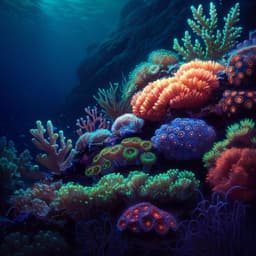
Environmental Studies and Forestry
Geostationary satellite reveals increasing marine isoprene emissions in the center of the equatorial Pacific Ocean
W. Zhang and D. Gu
This groundbreaking research conducted by Wentai Zhang and Dasa Gu explores the significant variations in marine isoprene emissions across the western Pacific and eastern Indian Oceans. Discover how unexpectedly high emissions in the central equatorial Pacific Ocean challenge previous understandings, alongside intriguing satellite observations linking NO2 and aerosol formation from isoprene in the remote ocean.
~3 min • Beginner • English
Introduction
The study investigates how marine isoprene emissions vary spatially and temporally over the western Pacific and eastern Indian Oceans and assesses their implications for atmospheric chemistry and climate. Isoprene, a key biogenic VOC, affects cloud processes and secondary organic aerosol (SOA) formation. While terrestrial sources dominate globally, marine isoprene from phytoplankton and other marine organisms can influence remote ocean-atmosphere chemistry, particularly during phytoplankton blooms. Large discrepancies (up to two orders of magnitude) exist among previous marine isoprene emission estimates due to limited continuous in-situ data and incomplete understanding of marine production and loss mechanisms, including potential contributions from sea surface microlayer (SML) photochemistry. Leveraging high-resolution geostationary satellite (Himawari-8) products with a process-based model, the authors aim to: (1) elucidate spatial and temporal distributions of marine isoprene emissions; (2) quantify trends and attribute them to biological and physical drivers; and (3) assess potential impacts on air quality and climate. They report a prominent emission pool and significant positive emission trend in the center of the equatorial Pacific Ocean (CEPO) from 2015–2020.
Literature Review
Prior work has identified marine phytoplankton as the primary source of oceanic isoprene, with contributions also from heterotrophic bacteria and seaweeds. Laboratory, mesocosm, and in-situ studies have examined dependencies on biomass, phytoplankton functional types (PFTs), light, and temperature. Bottom-up and top-down approaches have yielded widely varying global emission estimates due to limited measurements and uncertain production and loss processes. Some field and laboratory studies proposed SML photochemical production as a missing source, though underway eddy covariance flux measurements did not show a robust correlation with shortwave radiation. Marine isoprene-derived SOA can affect coastal air quality and extend inland, with prior observations linking isoprene emissions to aerosol properties and suggesting IEPOX pathways under low-NOx conditions. Temperature adaptation, community composition shifts, and environmental variability influence PFT distributions and emission factors, complicating large-scale prediction.
Methodology
Study domain: 120°E–160°W, 60°S–60°N, August 2015–December 2020. Core data: Himawari-8 L3 chlorophyll-a (Chl-a), sea surface temperature (SST), photosynthetically active radiation (PAR), aerosol optical depth (AOD); sea surface height (SSH); wind speed and wind stress reanalyses; Argo-based ISAS temperature fields/climatology; OMI tropospheric NO2, HCHO; OMI/MLS tropospheric O3. Modeling framework: A marine isoprene emission model includes phytoplankton isoprene production, chemical and biological loss, vertical mixing loss, diffusion to deeper ocean, seawater-to-air flux, and SML photochemical flux. Phytoplankton production rate p(h) depends on PFT-specific emission factor (EF), temperature, and light following a log-squared light response with an empirically fitted temperature dependence (parameters α1, α2, α3 from diatom experiments). PAR attenuation with depth is computed via Beer–Lambert’s law using diffuse attenuation coefficient kd derived from Chl-based bio-optical relationships. PFT identification is performed from MODIS-Aqua using the PHYSTWO algorithm, retrieving six PFTs (Coccolithophorids bloom, Phaeocystis-like, Diatoms, Synechococcus, Prochlorococcus, Nanoeukaryotes) with literature-based EFs. Vertical structure: A multiple linear regression (MLR) relates subsurface temperature profiles to satellite SST, SSH, and wind stress, trained and evaluated against ISAS Argo fields. Mixed layer depth (DML) is diagnosed by a temperature threshold method (ΔT = 0.2 °C). The euphotic depth Hmax is where PAR is reduced to 2.5 W m−2 and is computed from kd; Chl-a used in production is the euphotic-layer mean, obtained by converting surface Chl to column Chl_tot and dividing by Hmax. Production integration: Isoprene production P is integrated from the surface to min(Hmax, DML) and scaled by Chl and a prefactor β calibrated so that modeled mean seawater concentrations match in-situ data (T/S Osyoro-maru Cruise No. 56). Steady-state seawater concentration Cm is computed by balancing production against biological loss (k_bio proportional to Chl), chemical loss (k_chem), downward mixing loss (k_mix), and seawater-air flux (Focean). Air-sea flux: Total marine flux equals seawater flux (driven by air-sea gas exchange parameterized with wind speed and SST through Schmidt number and transfer velocity) plus SML photochemical flux (photosensitized production parameterized with PAR, SML properties). Trend and correlation analysis: For each grid cell, trends in emissions and environmental drivers (Chl-a, SST, PAR, wind speed), and atmospheric variables (AOD, O3, NO2, formaldehyde) are evaluated using the Mann–Kendall test (α = 0.05) and Theil–Sen slope estimator; uncertainties on non-zero slopes are quantified via the EES method. Correlations between isoprene flux and drivers are computed spatially. Sensitivity tests: A baseline case with median constant parameters and six perturbation runs (varying one of Chl-a, SST, PAR, EF, Hmax, DML while holding others constant) quantify parameter contributions to spatial patterns of emissions and seawater concentrations. Data sources and processing are as listed in Data Availability.
Key Findings
- Spatial patterns and magnitudes: Mean marine isoprene emission flux over the domain during Aug 2015–Dec 2020 is 6.5 nmol m−2 h−1, similar between coasts (6.5) and open ocean (6.4). Among open oceans, East Indian Ocean (EIO) has higher flux (6.9) than North Pacific (NPC) and South Pacific (SPC) (both 6.2). Seawater flux contributes 70–85% of total marine flux, reaching ~90% in some coastal regions. Extrapolating the mean yields a tentative global estimate of ~1.2 Tg C yr−1 (with large uncertainty).
- Emission hotspots: Notable high fluxes occur in CEPO (7°S–5°N, 175°E–160°W) at 7.4 nmol m−2 h−1 and in the Tasman Sea at 8.7 nmol m−2 h−1. CEPO emissions are about 18–20% higher than NPC/SPC. Despite lower seawater isoprene concentrations in the Tasman Sea (62.7 pmol L−1) compared to CEPO (84.2 pmol L−1), higher wind speeds (8.3 vs 5.6 m s−1) enhance air–sea transfer; SSTs are ~16.3 °C (Tasman) vs ~28.7 °C (CEPO).
- Trends (Aug 2015–Dec 2020): Significant increasing trends are localized in CEPO; elsewhere trends are generally insignificant. In CEPO, marine isoprene absolute trend is 401 ± 4 pmol m−2 h−1 yr−1, relative trend 5.5 ± 0.1% yr−1. Seawater flux trend: 342 ± 4 pmol m−2 h−1 yr−1 (5.9 ± 0.1% yr−1). SML flux trend: 75 ± 1 pmol m−2 h−1 yr−1 (5.0 ± 0.1% yr−1).
- Driver trends in CEPO: Chl-a increases 7.1 ± 0.1% yr−1; SST decreases −8.8 ± 0.1% yr−1; PAR increases 20.1 ± 0.2% yr−1; wind speed increases 44.4 ± 0.4% yr−1, aligning with emission increases.
- Correlations: In CEPO, marine isoprene flux correlates positively with wind speed, Chl-a, and PAR, and negatively with SST. Across the domain, isoprene–SST correlations are negative in tropical/subtropical waters and positive at high latitudes, consistent with temperature optima for production. Wind shows positive correlations at latitudes <30° and negative at >30° due to competing effects on gas exchange and mixed-layer dilution.
- Atmospheric impacts: Isoprene flux generally correlates positively with AOD. In CEPO, NO2 modulates AOD response to isoprene: for NO2 > 2.5 × 10^14 molecules cm−2, AOD increases rapidly with isoprene (slope ≈ 1.5×10^−2, R^2 = 0.42), whereas for NO2 < 2.4 × 10^14 molecules cm−2, the increase is weaker (slope ≈ 4.4×10^−3, R^2 = 0.065), suggesting NO2 facilitates SOA formation from isoprene under remote ocean conditions. Periods with high isoprene flux (>8.0 nmol m−2 h−1) and AOD (>0.15) coincide with below-average tropospheric O3 (~34.5 DU), consistent with NOx-limited O3 sensitivity and potential O3 suppression by increased isoprene. The 2015/16 strong El Niño overlapping CEPO (Niño-4) may have linked elevated emissions to upper-tropospheric organic aerosol formation.
Discussion
The findings demonstrate a distinct emission pool and accelerating marine isoprene emissions in the CEPO, addressing the need for spatiotemporal constraints on marine isoprene. The modeled linkage between increased emissions and environmental changes (higher Chl-a, PAR, wind, and lower SST) explains the observed trends, with seawater flux dominating the total emission increase. Correlation patterns across latitude bands align with known temperature optima and physical controls on gas exchange and mixing. The observed dependence of AOD enhancement on NO2 abundance indicates that even in remote oceanic air, NO2 can catalyze SOA formation from isoprene oxidation, while increased isoprene under NOx-limited conditions may suppress O3. These results highlight the sensitivity of marine atmospheric chemistry and cloud-relevant aerosol to ocean biogeochemistry and physical forcing, and suggest that interannual climate variability (e.g., El Niño) can modulate marine organic aerosol via isoprene. While correlations do not establish causation, the convergence of trends and process-consistent relationships supports the role of biological and physical drivers in the CEPO emission increase and its atmospheric impacts.
Conclusion
This work integrates geostationary satellite observations with a process-based ocean isoprene model to map and quantify marine isoprene emissions over the western Pacific and eastern Indian Oceans from 2015 to 2020. It reveals a prominent emission pool in the CEPO with emissions approximately 18–20% higher than the surrounding Pacific and a significant increase of 5.5% per year over 65 months, primarily driven by seawater flux. Statistical relationships indicate strong linkages to increasing Chl-a, PAR, and wind speed and decreasing SST. Analysis of satellite AOD and trace gases suggests NO2 plays a critical role in enhancing isoprene-derived SOA in remote marine air and that increased isoprene may suppress O3 under NOx-limited conditions. The study underscores the importance of marine isoprene for regional air quality and climate and provides an initial demonstration of rapid emission enhancement in remote tropical oceans. Future work should prioritize broader and sustained in-situ flux and concentration measurements across tropical oceans, improved characterization of PFT-specific emission factors, better constraints on SML photochemistry, and coupled ocean–atmosphere modeling to quantify radiative and air quality impacts.
Limitations
- The global extrapolation of emissions from the study domain carries large uncertainties and is only indicative. - The model relies on satellite proxies (Chl-a, PAR, SST, SSH, winds) and empirical relationships for subsurface temperature, light attenuation, and mixed-layer depth, which introduce uncertainties. - PFT identification and emission factors are uncertain and shown by sensitivity tests to strongly influence emissions. - The steady-state assumption for seawater concentrations and parameterized loss processes (biological, chemical, mixing) simplify complex dynamics. - SML photochemical production is parameterized; SML presence can be disrupted by high winds, adding variability. - Correlation-based attribution does not establish causality; confounding environmental factors and climate modes (e.g., El Niño) may influence results. - Spatial coverage is limited to the western Pacific and eastern Indian Oceans; in-situ flux measurements within CEPO and other regions are sparse.
Related Publications
Explore these studies to deepen your understanding of the subject.







